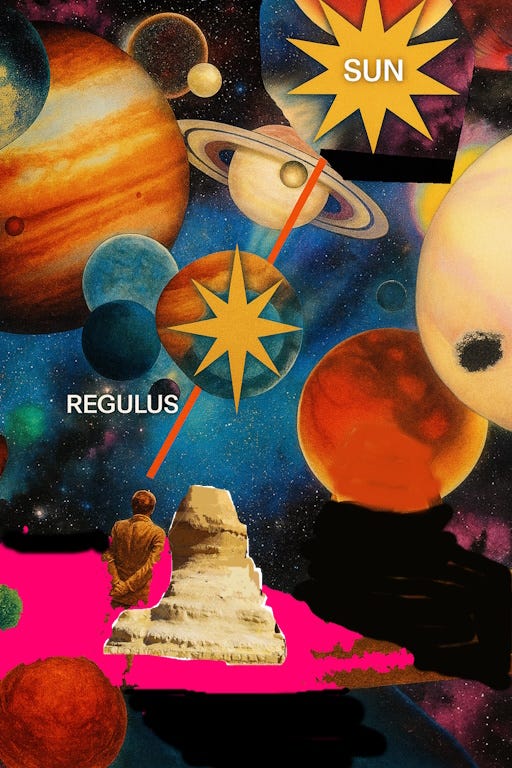Regulus Rising in the Gaze of the Sphinx

Every civilisation has watched the sky for meaning, not because the heavens control us, but because they mirror the inner movements of a species learning to understand itself. On April 26, 2026, something aesthetically simple happens: the star Regulus rises before the Sun in the direction of the Great Sphinx’s gaze. Astronomically, the sky has performed this gesture many times. Yet symbols gather power from context, not rarity, and this particular alignment arrives at a moment when humanity is entering one of the most introspective phases of its collective development.
Regulus, the ancient heart of the constellation Leo, was long understood as a star of visibility, sovereignty, renewal, and the thresholds between eras. When Regulus rose heliacally — appearing just before dawn — ancient cultures treated it as a sign that the world was entering a new arc of attention. It was not a star of prediction but a star of orientation. It marked the year’s tonal shift. It said: look here, something is changing in humanity’s relationship to itself.
The Sphinx, placed deliberately facing due east, continues to watch the horizon where illumination is born each morning. It is the guardian of sunrise, the keeper of thresholds. The Sphinx does not face east because of Egypt’s relation to Asia; it faces east because east is where light appears, where the day’s first knowledge emerges from darkness. When Regulus rises along this exact axis, the symbolism becomes powerful even if nothing supernatural happens in the sky.
The question is not whether something will happen on Earth because Regulus rises in that direction. The real question is why this moment matters in the human story — why the symbolism returns now, and why so many people feel a shift coming in how humanity thinks, perceives, and understands itself.
The world of 2026 is psychologically different from the world that came before. People are moving inward, not outward. The old structures of belief, authority, power, and identity are loosening. There is a growing recognition that society evolves not only through political or technological transitions but through subtle changes in perception. What the ancients would have called “illumination” is today understood as coherence, self-awareness, insight, and the dissolving of the inner noise that once dominated human thought.
Regulus rising in the Sphinx’s gaze, at this time in history, becomes a mirror of this psychological shift. It symbolises a turning point in how humans understand their own mind. Not a prophecy — a reflection. A sign that the age of spectacle and external power is slowly giving way to the age of inner clarity, where meaning comes from within rather than being externally imposed.
The date matters because of the global atmosphere, not because of the star. By 2026 the world stands at a threshold: technologies are merging with consciousness, societies are questioning inherited narratives, and individuals are rediscovering silence as a source of intelligence. The Sphinx-Regulus alignment becomes a cultural symbol reminding humanity that knowledge does not only advance through information, but through the return to the space from which insight arises.
When Regulus rose in ancient skies, it was always associated with the renewal of kingship. But kingship was not merely political; it meant alignment between the individual and the deeper order of life. In 2026 that renewal points not to leaders but to the psyche itself. The “sovereignty” returning is the sovereignty of awareness — the ability to see without distortion, to live from the centre, to recognise the quiet intelligence that underlies all thought.
The alignment on April 26 does not instruct the universe; it reflects the state of the human mind. In this sense, it is profoundly relevant. It signifies a moment when humanity becomes ready to integrate what many individuals have already discovered: that clarity arises not from belief, but from silence; not from authority, but from understanding; not from external identity, but from the inner coherence that appears when the noise of thought dissolves.
The Sphinx watches the rising of Regulus not as a cosmic event, but as a reminder that knowledge always precedes illumination. Insight appears before the world realises what it means. A star rises before the Sun. Clarity precedes change. And society moves toward what individuals have already begun to see.
This is not a prediction; it is a symbol. And symbols matter because they help us understand what we are already becoming.
